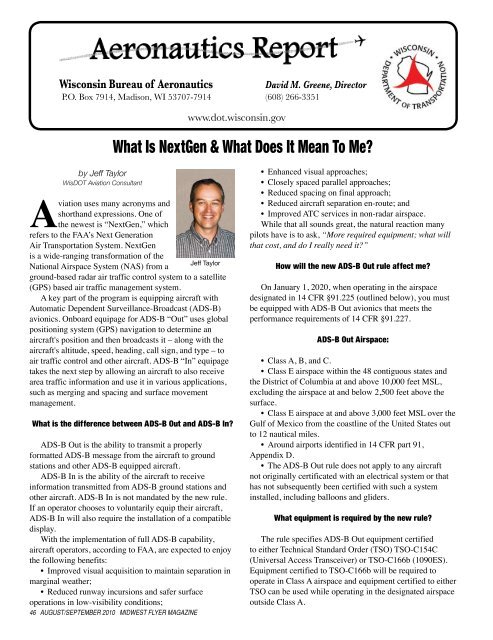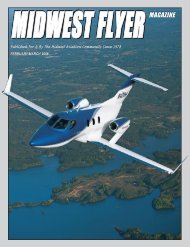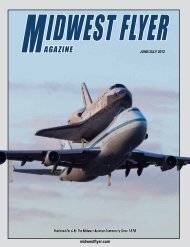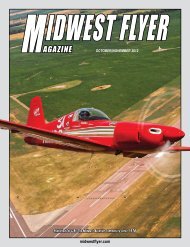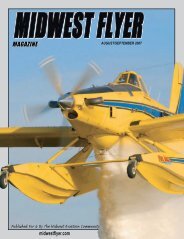AGAZINE - Midwest Flyer
AGAZINE - Midwest Flyer
AGAZINE - Midwest Flyer
Create successful ePaper yourself
Turn your PDF publications into a flip-book with our unique Google optimized e-Paper software.
Wisconsin Bureau of Aeronautics <br />
<br />
David M. Greene, Director<br />
P.O.<br />
<br />
Box 7914, Madison, WI 53707-7914<br />
<br />
(608) 266-3351<br />
<br />
www.dot.wisconsin.gov<br />
by Jeff Taylor<br />
WisDOT Aviation Consultant<br />
Aviation uses many acronyms and<br />
shorthand expressions. One of<br />
the newest is “NextGen,” which<br />
refers to the FAA’s Next Generation<br />
Air Transportation System. NextGen<br />
is a wide-ranging transformation of the<br />
Jeff Taylor<br />
National Airspace System (NAS) from a<br />
ground-based radar air traffic control system to a satellite<br />
(GPS) based air traffic management system.<br />
A key part of the program is equipping aircraft with<br />
Automatic Dependent Surveillance-Broadcast (ADS-B)<br />
avionics. Onboard equipage for ADS-B “Out” uses global<br />
positioning system (GPS) navigation to determine an<br />
aircraft's position and then broadcasts it – along with the<br />
aircraft's altitude, speed, heading, call sign, and type – to<br />
air traffic control and other aircraft. ADS-B “In” equipage<br />
takes the next step by allowing an aircraft to also receive<br />
area traffic information and use it in various applications,<br />
such as merging and spacing and surface movement<br />
management.<br />
What is the difference between ADS-B Out and ADS-B In?<br />
ADS-B Out is the ability to transmit a properly<br />
formatted ADS-B message from the aircraft to ground<br />
stations and other ADS-B equipped aircraft.<br />
ADS-B In is the ability of the aircraft to receive<br />
information transmitted from ADS-B ground stations and<br />
other aircraft. ADS-B In is not mandated by the new rule.<br />
If an operator chooses to voluntarily equip their aircraft,<br />
ADS-B In will also require the installation of a compatible<br />
display.<br />
With the implementation of full ADS-B capability,<br />
aircraft operators, according to FAA, are expected to enjoy<br />
the following benefits:<br />
• Improved visual acquisition to maintain separation in<br />
marginal weather;<br />
• Reduced runway incursions and safer surface<br />
operations in low-visibility conditions;<br />
46 AUGUST/SEPTEMBER 2010 MIDWEST FLYER M<strong>AGAZINE</strong><br />
• Enhanced visual approaches;<br />
• Closely spaced parallel approaches;<br />
• Reduced spacing on final approach;<br />
• Reduced aircraft separation en-route; and<br />
• Improved ATC services in non-radar airspace.<br />
While that all sounds great, the natural reaction many<br />
pilots have is to ask, “More required equipment; what will<br />
that cost, and do I really need it?”<br />
WisDOT Maskhead CMYK Feb09.indd 1 1/23/09<br />
khead.indd 1<br />
WISDOT MaskheadFeb09.indd 1<br />
What Is NextGen & What Does It Mean To Me?<br />
How will the new ADS-B Out rule affect me?<br />
On January 1, 2020, when operating in the airspace<br />
designated in 14 CFR §91.225 (outlined below), you must<br />
be equipped with ADS-B Out avionics that meets the<br />
performance requirements of 14 CFR §91.227.<br />
ADS-B Out Airspace:<br />
• Class A, B, and C.<br />
• Class E airspace within the 48 contiguous states and<br />
the District of Columbia at and above 10,000 feet MSL,<br />
excluding the airspace at and below 2,500 feet above the<br />
surface.<br />
• Class E airspace at and above 3,000 feet MSL over the<br />
Gulf of Mexico from the coastline of the United States out<br />
to 12 nautical miles.<br />
• Around airports identified in 14 CFR part 91,<br />
Appendix D.<br />
• The ADS-B Out rule does not apply to any aircraft<br />
not originally certificated with an electrical system or that<br />
has not subsequently been certified with such a system<br />
installed, including balloons and gliders.<br />
What equipment is required by the new rule?<br />
The rule specifies ADS-B Out equipment certified<br />
to either Technical Standard Order (TSO) TSO-C154C<br />
(Universal Access Transceiver) or TSO-C166b (1090ES).<br />
Equipment certified to TSO-C166b will be required to<br />
operate in Class A airspace and equipment certified to either<br />
TSO can be used while operating in the designated airspace<br />
outside Class A.<br />
2/13/09 3:24:41 PM<br />
7/20/08 12:22:11 PM


